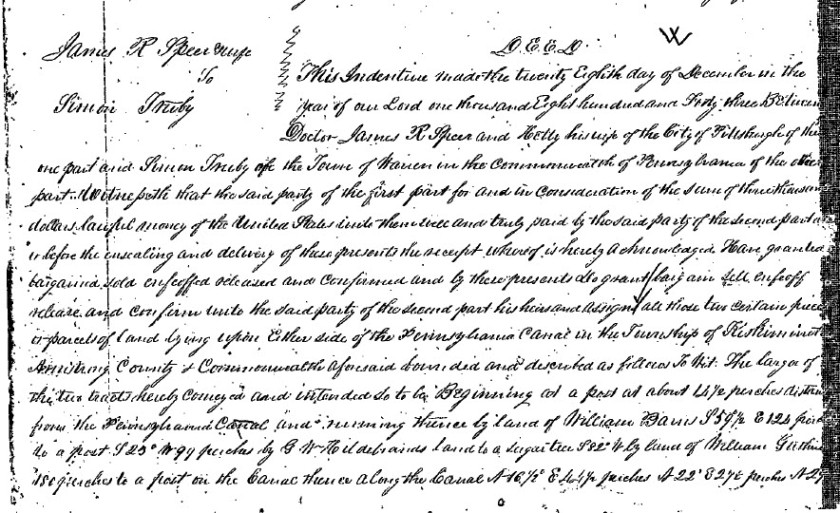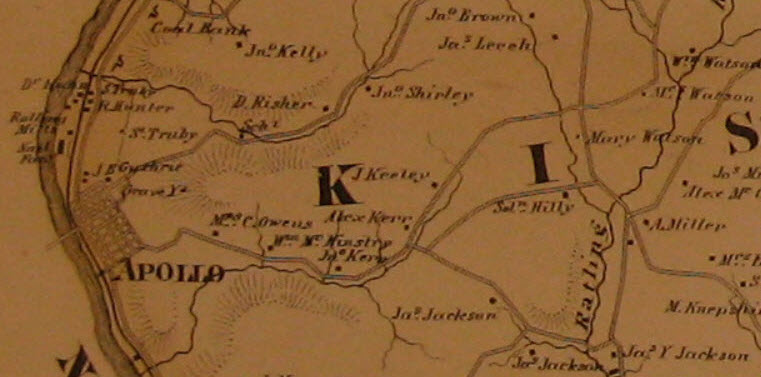Where do you begin researching the story of an old house? You can try googling the address, but that will only get you so far. Real estate websites like Zillow and Trulia will list what year the house was built—a date usually drawn from county tax records—but such dates may not be accurate for older houses, especially those built before 1900.
In my case, I started with my memory of a dot on a map in the Apollo Memorial Library.
As mentioned in my first blog post, my mom and I recalled seeing that dot—labeled Truby, a farmer—on an early map of Apollo. Forty years ago, we suspected that dot might be our house on Terrace Ave. But today, with the Web at our fingertips, how could we learn more about Mr. Truby and his house? When our research began, we didn’t know Truby’s first name, and we weren’t even certain that the dot represented our house.
Eventually I discovered the convenient but pricey option of searching through Armstrong County deeds online at the Landex Webstore. Free Web searches in the Landex database provide basic info: the names of seller and buyer, the town, and the year the deed was recorded, which can be a useful start. But to see the full document, you either must pay Landex a per-document fee to download the PDF, which can quickly add up, or you can go in person to the Register and Recorder in the Armstrong County Courthouse in Kittanning, Pennsylvania. There you can view the online deeds for free, but printing will cost you. I ended up doing a combination of both, pouring over archaic land records.
My initial Landex deed searches for Truby were not helpful! Many lads named Truby were buying land throughout Armstrong County in the early 1800s, and none of the deeds before 1850 was listed as being in Apollo or Warren (as Apollo was known before 1848). I tried looking at old census records on the free federal websites, but those early records didn’t include street addresses.
This may be obvious to some, but it took me weeks to figure out that the best approach was to follow the deed trail backwards, beginning with the present-day owner. You know what they say: One good deed deserves another!
Here’s the most recent deed for the Truby farmhouse, dated 1975, wherein the land is granted by William Dale Hunter and Marjorie Hunter to Rebecca L. Contie (my mom).

The deed’s second page (below) includes 2 key pieces of information:
- The old Truby farmhouse currently sits on a tract of land known as “Lot 8 in the block A of the Apollo Improvement Company Plan of Apollo Borough and Suburbs.” I’d never heard of THAT before! (More to come in a future blog post.)
- That same lot of land had been conveyed to Mr. & Mrs. Hunter by deed of Paul G. Adams and wife in 1961. And so the deed chain rolls backwards through earlier generations, providing new clues to the house’s history

Every deed will tell you who the previous landowner was and when the previous sale was made, so you can begin your next deed search in that earlier era. You can also search for the previous deed by looking at the deed book volume and page number for the previous sale. In the case of my mom’s deed above, the previous sale was recorded in Deed book volume 460, page 618. The staff in the courthouse can help explain how the computer search works; its a little tricky at first.
As you proceed backwards in time, handwritten deeds become the norm, and they can be extremely difficult to read. But it’s worth the effort to try. It turns out that deeds—especially the older ones—can contain unexpected historical and genealogical details.
Venturing further back in time, I eventually uncovered the deed that conveyed the 156+ acres of land from James R. Speer and his wife Hettie to Simon Truby and his first wife Sarah in 1843. The first page of the deed is below. The script is beautiful, but oy is it hard to read! You can download a PDF of the full 3-page deed here. Tracing backward 6 deeds before this 1843 deed, this same plot of land was part of a larger tract surveyed to John Montgomery and conveyed to him in January 17, 1775, by John Penn, son of William Penn, as recorded in Westmoreland County, PA, in Patent Book A.

Traveling along the deed trail, I came up with this chronological list of owners for the Truby farmhouse, though it gets a little murky in 1929 through 1937, when the bank owned the property. The chain of ownership for the Truby homestead beginning in the mid-1800s is:
- 1843 to 1892. Simon Truby’s name was on the deed even after he died in 1886. He’d left the farmland to his wife Elizabeth, but estate battles ensued. Truby heirs eventually conveyed the majority of the farm to the Apollo Improvement Company.
- Feb to Aug, 1892. The Apollo Improvement Company divided the farmland up into hundreds of lots and gradually sold them off. Today, dozens of families in Apollo and North Apollo live on the old Truby estate. Lots 8 and 9 were sold to Simon’s son Henry Hill Truby, along with the old brick farmhouse. Several of Simon’s other sons and daughters purchased nearby lots and built their own houses. (Details to come in a future blog post.)
- 1892 to 1924. Henry Hill Truby (Simon’s eldest son) purchased lot 8, including the farmhouse, and lot 9, which included a chicken coop and outbuildings along the alley. In 1924, widower Henry sold most of the property to his son Clark, with the stipulation that Henry could continue to live in the farmhouse for the rest of his life. Henry died in 1927 at the age of 77.
- 1924 to 1929. Clark Owens Truby owned the Truby farmhouse until 1929, when it was repossessed by the Sheriff. I wish I could uncover more details of the circumstances. Clark was the last Truby to own the house.
- 1929 to 1937 (the murky years). The Citizens Bank of Vandergrift owned the property, although there seem to be some hard-to-decipher maneuverings during that 17-year period that I haven’t yet sorted out.

. Grace & Matthew Baer owned the Truby farmhouse from 1937 to 1945. Photo courtesy of Debra Baer Litz. - 1937 to 1945. Grace & Matthew Baer. (see photo)
- 1945 to 1961. Mae & Paul Adams. After Mae died, Paul sold the home to his daughter Margie and her husband Dale.
- 1961 to 1976. Margie & Dale Hunter.
- 1975 to today. Becky (Contie) Frayer.
Deed tracking can be a great start to uncovering a house’s history. But important clues can also be found in maps, census records, address books, personal anecdotes, and newspaper accounts. Here are some other resources that share tips for tracing the history of a house:
- How to trace a house genealogy (Carnegie Library of Pittsburgh)
- How to research the history of your house (This Old House magazine)
But beware. Once you get started researching a house history, you’ll uncover endless trails to pursue, many deadends, and reams of documents and digital files. Proceed with caution. You might find yourself falling in love with the ghosts of the town.
The map at the very top of this blog post is a portion of the 1861 Pomeroy map of Kiski Twp, Pennsylvania, which was not available online when I first began my research in 2013. The map can now be seen in its entirety here, which feels like a miracle for house-history researchers. God bless ancestortracks.com !
– Vicki Contie

Thank you for digging up the history on this beautiful house! I can’t wait to read your next post.
LikeLike
I’ve been reading these as a general interest piece, as I’m considering a visit to my grandparent’s graves in the Apollo cemetery. I was last there in the mid 1980s, so I thought a little research might help bring me up to date. But imagine my surprise when I reached the end of this article and found that your mother and I share a last name! In fact, it would be my Grandma and Grandpa Frayer I hope to come pay respects to. I wonder if we’re relatives?
LikeLike
Hi Sade Linn, Thanks for writing! My mom’s second husband was Paul Edward Frayer Jr, who grew up in Etna PA. He’s buried next to my mom in the Apollo Riverview Cemetery. His parents were Paul & Elda Frayer of Etna PA; I think Paul & Elda are buried in a cemetery closer to Pittsburgh. I’m not familiar with other Frayers in the Apollo area. Are you related to Paul E Frayer Jr?
LikeLike
Not that I’m aware of, but I don’t really know who all may be out there. My dad was an only child, son of Wallace & Vernye Frayer, both buried in the Apollo cemetery. Wally’s father was George Washington Frayer, about whom I know little other than he was born 1864. I think my grandfather grew up in Vandergrift; my grandmother Vernye grew up in Sugar Hollow – which I’ve only recently seen mentioned on the map to know it was on the edge of Apollo. I’ve never met anyone with our spelling of the last name which is why it stood out to me!
LikeLike